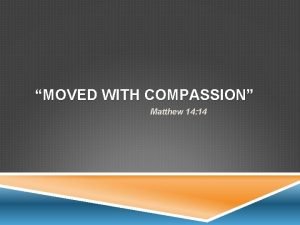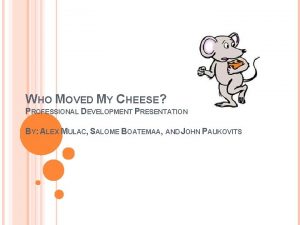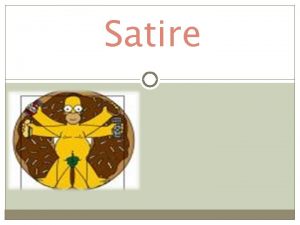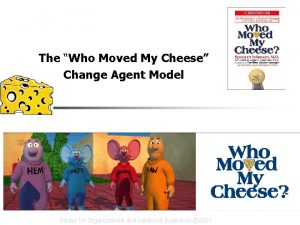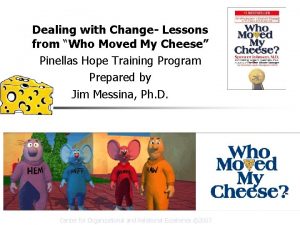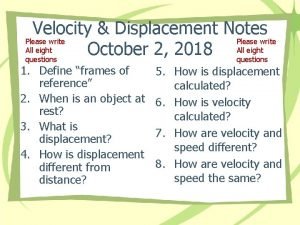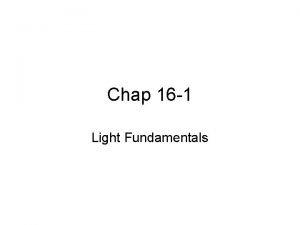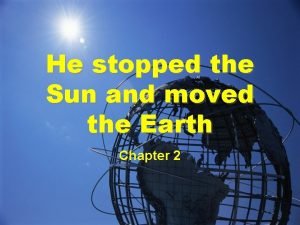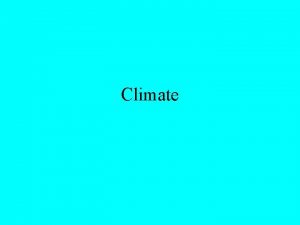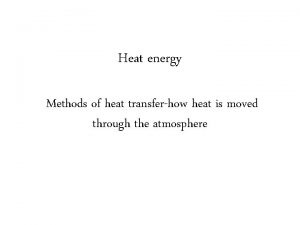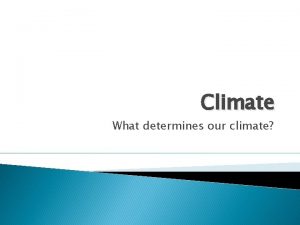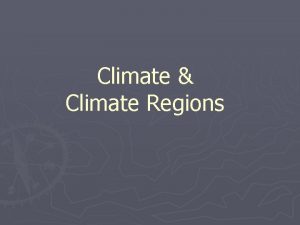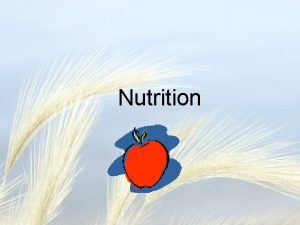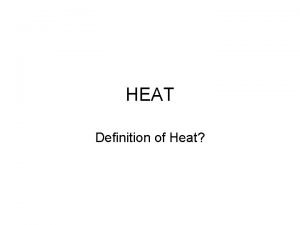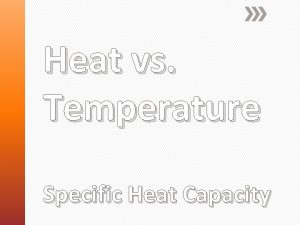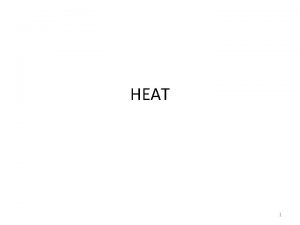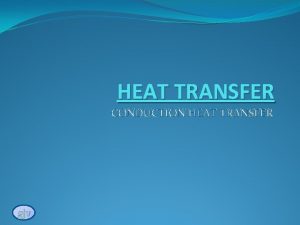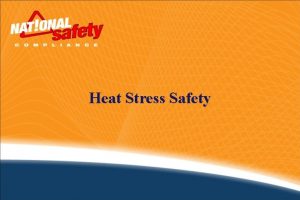Climate Heat transferhow heat is moved through the






















































- Slides: 54

Climate

Heat transfer-how heat is moved through the atmospherealways transferred from warmer to cooler object • 1. Conduction- heat transferred through direct contact. (Ex: metal spoon in boiling pot) • 2. Radiation- heat transferred from sun to earth’s surface • 3. Convection- cycle of warm rising, cool sinking due to differences in density ( Ex: Magma inside the earth, warm & cold fronts)

What type of heat transfer is this? How is the heat transferred?

Angle of Insolation (incoming solar radiation) – angle at which the Sun heats the earth

Three Things Can Happen to Light Refraction - if the object is transparent or translucent light will pass through the object and may be bent. 2. Reflection - light may reflect from the surface of the object, 1. 3 Absorption – Upon striking an object light may be converted to heat.

Definition • Climate is the average weather in a location over a long period of time. Ex: A place that doesn't get much rain over many years would have a dry climate. – A place where it stays cold for most of the year would have a cold climate.

World Climates- 3 main groups o 0 -23. 5 1 -Low-latitude (Tropical) o 23. 5 -66. 5 2 -Mid-latitude (Temperate) o 66. 5 -90 3 -High-latitude (Polar)

Latitude • Latitude: The distance from the equator measured in degrees • Temperature Zones – Tropical Zones: warm climates – Temperate Zones: ranging temperatures (seasonal) – Polar Zones: cold climates


Classifying Climate • Temperature • Precipitation 6 major climate groups 1. Tropical rainy 2. Dry 3. Temperate marine 4. Temperate continental 5. Polar 6. Highlands

Climate graph (Climograph)- shows precipitation and temperature of a location bars = precipitation lines = temperature

Temperate- seasonal Northern Hemisphere- look at temperature line in J, J, A

Tropical, Southern Hemisphere





5 factors of climate 1) Latitude- distance from equator 2) Altitude- (mountain) 3) Global Winds- trade winds, prevailing westerlies, polar easterlies 4) Ocean currents- warm/cool climates 5) Nearness to center of continent or large body of water 1) Specific heat – inland v. coastal 2) Windward v. Leeward side of mountain

Important facts on Climate: • • Factors affecting climate include: ‣Latitude- The higher your latitude, the colder your climate. ‣Altitude- The higher your altitude, the colder your climate. ‣Mountain ranges- On the windward side of a mountain, your climate will be wet, on the leeward side of a mountain, your climate will be dry. ‣Oceans/Large Bodies of Water- The closer you are to water, the less extreme your climate (warmer winters and cooler summers). ‣Ocean Currents- Locations near warm water currents will have warmer climates, locations near cold water currents will have colder climates. ‣Planetary Wind Belts- On-shore winds will cause wet climates, offshore winds will cause dry climates (monsoon winds). 1) trade winds, prevailing westerlies, polar easterlies

OROGRAPHIC LIFTING • Occurs when there is a change in temperature of a gas caused by expansion or contraction of the gas WITHOUT the application or removal of heat. • ‣ Cooling: warm air ascends and expands. Expansion causes cooling (more space between molecules, less collisions between molecules). • ‣ Warming: cold air descends and is compressed by surrounding air. Compression causes warming (less space between molecules, more collisions between molecules). • ‣ Orographic lifting occurs when air is forced up by mountains, causing cooling, condensation, and precipitation on the windward side and warming and evaporation on the leeward side.

When air is forced to rise because it hits mountains, it will expand, cool, and condense - Windward side = a cool, moist climate. - Leeward side= a warm and dry climate



Which location is on the windward side? Leeward side?

What is the climate of Seattle? Spokane?

• Heating of Earth comes from Sun • This heating is UNEVEN • The uneven heating causes the air and ocean to MOVE • Because the earth is rotating, the motion CURVES

Coriolis Effect • The Coriolis force- affects the direction of wind flow due to earth’s rotation. • This force is what causes objects in the northern hemisphere to turn to the right and objects in the southern hemisphere to turn to the left.

Global Winds


Specific heat • The ability to resist being heated – Low specific heat = heat up and cool down fast – High specific heat = heat up and cool down slowly


Sea Breeze- Day • Water has a high Air sinks over water and moves to landspecific heat= takes H to L longer to warm up and cool down • Air over water is cooler, so it sinks and a breeze moves from water to land

Land Breeze- Night • At night , the land will cool down faster than the water- the breeze then moves from land to sea

TAKE A LOOK AT ANOTHER TWO LOCATIONS AT NEARLY THE SAME LATITUDE Nations Online Project: http: //www. nationsonline. org/oneworld/usa_map. htm

INLAND/COASTAL LOCATIONS: Average Jan and July Temperatures Seattle: High 47 F , Low 37 F July: High 75 F, Low 55 Bismarck: High 23 F , Low 2 F July: High 84 F, Low 56 F Cooler winter, warmer winter, Warmer summer= cooler summer= coastal locations inland locations From Weather channel: www. weather. com

Oceanic currents are driven by global winds and differences in water density

Some of the currents are moving warm water – and some are moving cool water Cool- start near poles and move towards equator Warm- start near equator and move towards poles From http: //tornado. sfsu. edu/geosciences/classes/m 356/Ocean. Currents/Global_currents. jpg

LETS COMPARE TWO PLACES NEAR THE OCEAN Halifax, Nova Scotia • Latitude 44. 67 o N • Average Jan temp High 29 o. F Low 13 o. F London, England • Latitude 51. 5072° N • Average Jan Temp High 5 oo. F Low 41 o. F

http: //www. holiday-weather. com

Key points on factors of climate • Water modifies temperature- Coastal locations will have warmer winters and cooler summers • Greater temperature range inland • Water heats up and cools off much slower than land-high specific heat • Latitude determines wet and dry zones • Warm ocean currents start near the equator and travel away from equator

1. Which locations are on the windward side of a mountain? Why? 2. Which is on the leeward side? 3. Out of B and C, which is has a greater range of temperatures? Why?

Monsoons • A monsoon is a seasonal change in the direction of the prevailing, or strongest, winds of a region. • Monsoons cause wet and dry seasons • Monsoons are most often associated with the Indian Ocean. • Monsoons always blow from cold to warm regions (H to L)


• http: //www. bom. gov. au/lam/Students_Teachers/elnanim/elani. shtml El Nino and La Nina • El Nino- Characterized by • La Nina- characterized unusually warm sea surface by unusually cold sea temperatures in the Pacific surface temperatures- Ocean- – wetter in West Pacific – drier weather in West Pacific, wetter in East Pacific and drier in East Pacific




Electromagnetic Energy • Insolation – incoming solar radiation – Direct- straight to earth’s surface – Diffuse- scattered or reflected by atmospheric elements (clouds) Infrared radiation • Electromagnetic radiation of a longer wavelength (red= heat)

Energy from the sun enters as shortwave radiation (visible, UV) and leaves as long-wave radiation (infrared)

Greenhouse effect • The natural heating of Earth’s surface by certain atmospheric gases • We could not live without the greenhouse effect • Greenhouse gases include: CO 2, water vapor, methane, and nitrous oxide • Any increase in these gases would cause an increase in absorbed radiation • This can lead to global warming! • Burning of fossil fuels, deforestation(cutting down trees), pollution causes global warming

Greenhouse effect

How is Carbon dioxide put into the atmosphere? When Do You Send Greenhouse Gases into the Air? Whenever you. . . Play a Video Game • Listen to a Stereo • Wash or Dry Clothes • Watch TV • Use a Dish • Use the Air Conditioner Washer • Turn on a Light • Microwave a • Use a Hair Dryer Meal • Ride in a Car

Acid Rain- result of sulfur and nitrogen oxides in the air -oxides travel with wind and when it precipitates, - it will be acid rain

 Climate change 2014 mitigation of climate change
Climate change 2014 mitigation of climate change Jesus was moved with compassion
Jesus was moved with compassion Who moved my cheese character traits
Who moved my cheese character traits Satire literary device
Satire literary device Handwriting on the wall who moved my cheese
Handwriting on the wall who moved my cheese Who moved my cheese lessons
Who moved my cheese lessons Who moved my cheese presentation
Who moved my cheese presentation Why did bruno's family suddenly moved house
Why did bruno's family suddenly moved house Since hanna moved away
Since hanna moved away Elements are moved between minerals during metamorphism by:
Elements are moved between minerals during metamorphism by: Pauls friend moved here from manteca california
Pauls friend moved here from manteca california A book is moved once around the edge of a tabletop
A book is moved once around the edge of a tabletop We will not be shaken we will not be moved
We will not be shaken we will not be moved A lamp is moved from 30 cm to 90cm
A lamp is moved from 30 cm to 90cm Who moved my cheese conclusion
Who moved my cheese conclusion Stopped the sun and moved the earth
Stopped the sun and moved the earth Thomas malthus concluded that
Thomas malthus concluded that Night of the scorpion talks about
Night of the scorpion talks about Through one man sin entered the world, and through one man
Through one man sin entered the world, and through one man Furcation dental definition
Furcation dental definition Advantage of through and through sawing
Advantage of through and through sawing Thẻ vin
Thẻ vin Thế nào là giọng cùng tên
Thế nào là giọng cùng tên Thể thơ truyền thống
Thể thơ truyền thống Alleluia hat len nguoi oi
Alleluia hat len nguoi oi Các châu lục và đại dương trên thế giới
Các châu lục và đại dương trên thế giới Hổ đẻ mỗi lứa mấy con
Hổ đẻ mỗi lứa mấy con Từ ngữ thể hiện lòng nhân hậu
Từ ngữ thể hiện lòng nhân hậu Diễn thế sinh thái là
Diễn thế sinh thái là Vẽ hình chiếu vuông góc của vật thể sau
Vẽ hình chiếu vuông góc của vật thể sau 101012 bằng
101012 bằng Tỉ lệ cơ thể trẻ em
Tỉ lệ cơ thể trẻ em Lời thề hippocrates
Lời thề hippocrates đại từ thay thế
đại từ thay thế Quá trình desamine hóa có thể tạo ra
Quá trình desamine hóa có thể tạo ra Các môn thể thao bắt đầu bằng tiếng đua
Các môn thể thao bắt đầu bằng tiếng đua Công thức tính thế năng
Công thức tính thế năng Thế nào là mạng điện lắp đặt kiểu nổi
Thế nào là mạng điện lắp đặt kiểu nổi Hình ảnh bộ gõ cơ thể búng tay
Hình ảnh bộ gõ cơ thể búng tay Khi nào hổ mẹ dạy hổ con săn mồi
Khi nào hổ mẹ dạy hổ con săn mồi Dot
Dot Biện pháp chống mỏi cơ
Biện pháp chống mỏi cơ Vẽ hình chiếu đứng bằng cạnh của vật thể
Vẽ hình chiếu đứng bằng cạnh của vật thể độ dài liên kết
độ dài liên kết Gấu đi như thế nào
Gấu đi như thế nào Thiếu nhi thế giới liên hoan
Thiếu nhi thế giới liên hoan điện thế nghỉ
điện thế nghỉ Một số thể thơ truyền thống
Một số thể thơ truyền thống Thế nào là hệ số cao nhất
Thế nào là hệ số cao nhất Trời xanh đây là của chúng ta thể thơ
Trời xanh đây là của chúng ta thể thơ Slidetodoc
Slidetodoc Số nguyên tố là
Số nguyên tố là đặc điểm cơ thể của người tối cổ
đặc điểm cơ thể của người tối cổ Vẽ hình chiếu vuông góc của vật thể sau
Vẽ hình chiếu vuông góc của vật thể sau Các châu lục và đại dương trên thế giới
Các châu lục và đại dương trên thế giới

